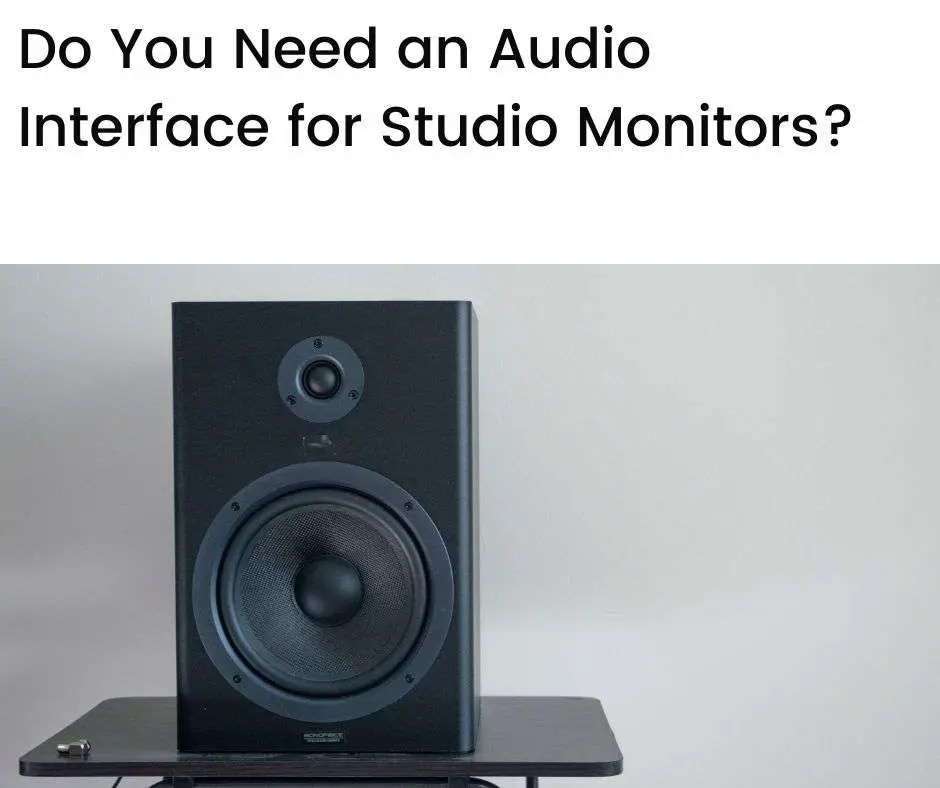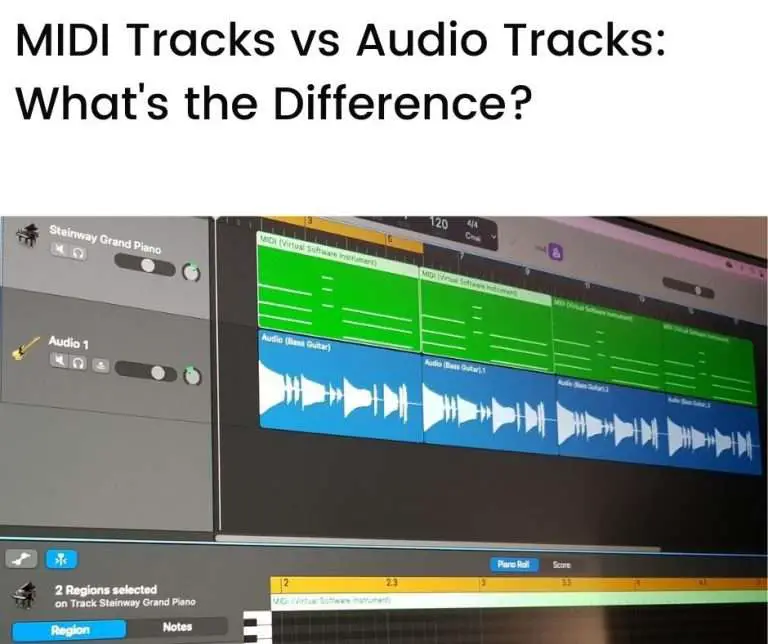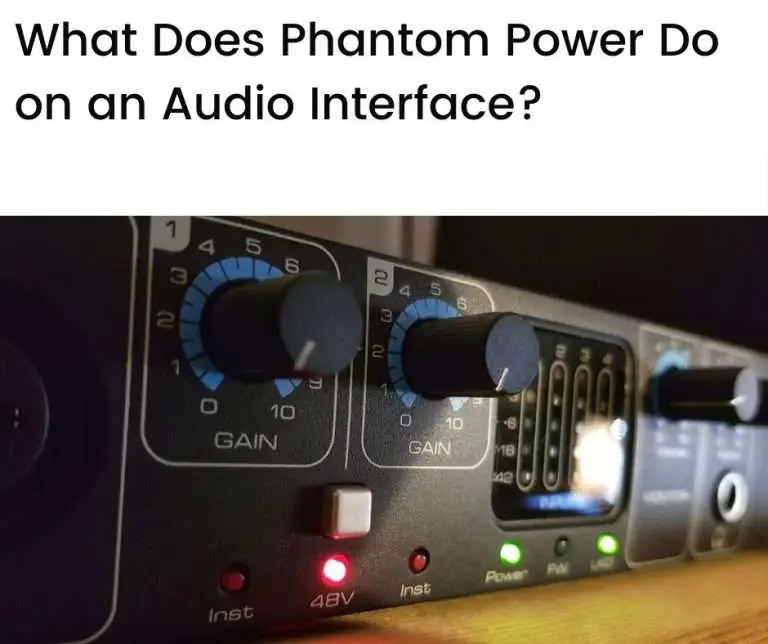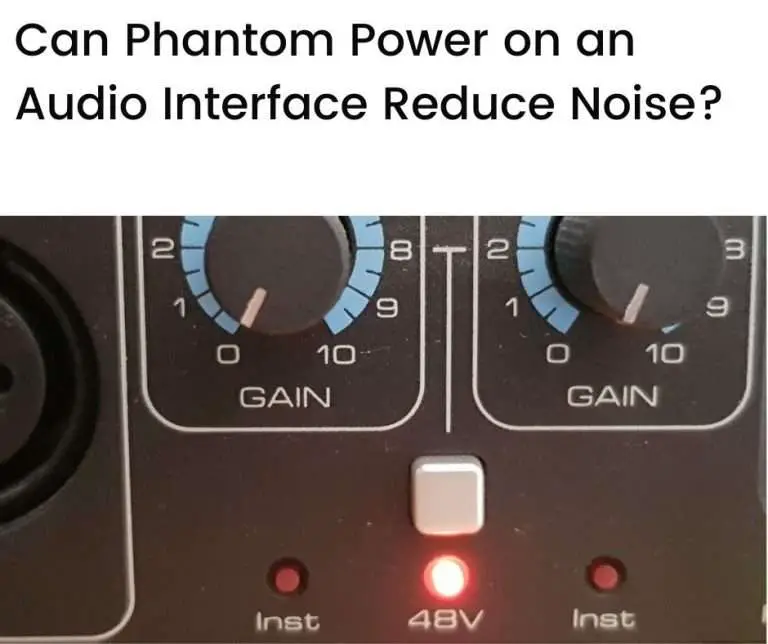No, you do not need an audio interface for studio monitors. However, most modern (digital) recording setups include audio interfaces for analog-to-digital conversion, and vice-versa, i.e., ADC and DAC, and the improved sound quality that they provide. But studio monitors, which typically include built-in amplifiers, can work with a range of inputs with or without audio interfaces.
In this article we’ll look at:
- What are studio monitors?
- What is an audio interface?
- Using studio monitors without an audio interface
- Conclusion
- FAQs
What are studio monitors?
Studio monitors are speakers designed to work in a recording studio or as part of a music production and playback setup.
Studio monitors are designed differently from regular speaker systems. This is because they need to reproduce sound accurately, i.e., with sonic accuracy, and not just in a way that sounds good for listening to recorded music.
Most studio monitors used in smaller setups have two-way loudspeakers, with a low-to-mid frequency driver and a high-frequency driver. This is simple enough for most home or small studio budgets while providing sufficient sonic accuracy.
One of the key features of studio monitors relates to whether they are active or passive, i.e., whether they include a built-in amplifier (active) or not (passive).
Most studio monitors designed for home setups are active and include a built-in amplifier.
Active monitors are convenient, as you don’t need to use a separate amplifier or matching cables. They also usually include driver-overload protection and are designed to optimally match the built-in amplifier with the speaker drivers.
What is an audio interface?
An audio interface sits at the heart of most sound recording systems that use computer technology.
Audio interfaces serve a range of purposes, such as bringing together several voice and instrument inputs, but one of their key functions is to convert analog audio signals to digital audio signals (ADC) and vice-versa (DAC).
Analog-to-digital conversion (ADC) is what allows instrument and voice inputs (analog) to be transferred to computers (digital) for editing and processing. Similarly, digital-to-analog conversion (DAC) transfers information from a computer system (digital) to outputs that can be heard by human ears (analog).
Audio interfaces are not necessary for recording or playback if computer (digital) processing is not a part of the system. However, most modern systems include a computer processing stage—usually with a digital audio workstation (DAW)—and use an audio interface as a part of the workflow.
As it happens, most computers include a built-in sound card that can do ADC and DAC processing, so an audio interface isn’t strictly required if a computer sound card can be used.
(The “sound card” may simply be a “sound chip” built into the computer’s motherboard—we’ll refer to both possibilities as a “sound card” in this article.)
But the processing power and output quality of these sound cards are typically inferior to an audio interface, so audio interfaces are preferred for studio setups where sound quality is important.
Using studio monitors without an audio interface
As we’ve seen, studio monitors and audio interfaces are separate pieces of equipment that can be used independently of each other. Let’s look at a few scenarios where you can use studio monitors without using audio interfaces.
1. Practicing an instrument
If you’re a musician who wishes to practice your guitar, you can simply plug your guitar into an active studio monitor to hear yourself play (or a passive studio monitor with matching amplifier and cables).
You don’t need an audio interface in this case.
You can also plug your guitar into a mixer or similar device, which in turn can be plugged into studio monitors. Again, you don’t need an audio interface for this setup.
Keep in mind that studio monitors are not designed to be guitar amps, which tend to be more robust and have different frequency response profiles than studio monitors. So, although you can plug directly into an active studio monitor to practice your guitar, a proper guitar amp is a better approach for this purpose.
The point here, however, is to illustrate that studio monitors can be used directly without the need for an audio interface.
2. Analog recording setup
In a completely analog setup, audio interfaces are not required as a part of the audio workflow. This is because there’s no need to convert sound between analog and digital signals in an analog setup.
Studio monitors would serve the same role in an analog setup as they would in a combined analog-digital setup. And they would operate normally without any audio interfaces.
In fact, analog recording setups (including studio monitors) were the standard approach for many years, before computer and digital technology became widely available and affordable.
3. Using your computer’s sound card
As mentioned, most computers include a built-in sound card that can convert sound between analog and digital signals (ADC and DAC). But the quality of the output from sound cards is generally inferior to what an audio interface can produce.
If you’re on a tight budget, however, or if the quality of output from a sound card is acceptable for your purposes, you can avoid using an audio interface. You can simply plug an instrument or microphone directly into your computer via the computer’s microphone jack, using an adapter if necessary.
In this case, you can include studio monitors in your audio setup and they will work just fine. You can simply pass the output audio signal from your computer to the studio monitors (using appropriate cables, amplification if necessary, and via any physical processing equipment that you may wish to use).
Conclusion
You do not need an audio interface in order to use studio monitors. They are separate pieces of equipment that work independently of each other.
Situations in which you can use studio monitors without an audio interface include practicing instruments directly through the monitors, using a completely analog audio setup, or using your computer’s built-in sound card as part of the audio workflow (replacing the need for an external audio interface).
Most modern recording setups, however, include an audio interface. This is because modern recording setups tend to use computer processing technology and audio interfaces provide improved sound quality compared with a computer’s sound card.
Studio monitors are, therefore, usually associated with audio interfaces in modern recording and playback setups. But as we’ve discussed, they don’t require audio interfaces to function properly and can work completely independently of audio interfaces.
FAQs
Do I really need an audio interface for my studio monitors?
No, you do not need an audio interface for your studio monitors. They are separate pieces of equipment and your studio monitors will work just fine without them. Most modern music production setups, however, do use an audio interface. This is because they sound better than most computer sound cards—they do a good job of converting analog audio to digital audio, and vice-versa—and they offer a convenient way of connecting various devices such as instruments, microphones, and (of course) monitors.
How do I connect my studio monitors to an audio interface?
To connect your studio monitors to an audio interface, you will need audio cables (usually XLR or TRS cables) that match the inputs on your monitors and interface. Simply connect the cables from the outputs on the audio interface to the inputs on your studio monitors.
Can I connect my studio monitors to a computer without an audio interface?
Yes, you can connect your studio monitors to a computer without an audio interface. But you’ll get better performance if you use an audio interface. An audio interface helps to optimize the sound quality by converting digital audio signals (from the computer) into analog signals (for your monitors) to a higher specification than your computer can do on its own (i.e., using the computer’s sound card).
What are the benefits of using an audio interface with studio monitors?
Using an audio interface with studio monitors provides several benefits such as improved sound quality, accurate audio playback, reduced latency, the ability to control volume and settings, and better integration with audio recording devices and software.
Can I use an audio interface to connect headphones?
Yes, most audio interfaces come with headphone outputs that allow you to monitor the audio signal with your headphones. This way, you can switch between studio monitors and headphones while working on your audio projects.
Can I connect studio monitors to a computer without an audio interface?
Yes, you can connect studio monitors to a computer without an audio interface using the headphone output or line outputs on the computer. However, it is not recommended. The sound quality may not be optimal, and you may experience issues with noise, distortion, or latency.
What is the best audio interface for my studio monitors?
The best audio interface for your studio monitors depends on your specific needs and budget. Some popular options include the Focusrite Scarlett series, Universal Audio Apollo series, and PreSonus AudioBox. It’s worth doing some research and reading reviews to find the right one for you.
What is the audio quality like when using an audio interface with studio monitors?
Using an audio interface generally improves the audio quality of your studio monitors. The interface helps to convert digital audio signals to analog signals with good specifications, providing accurate and high-quality sound reproduction with low noise and distortion.







